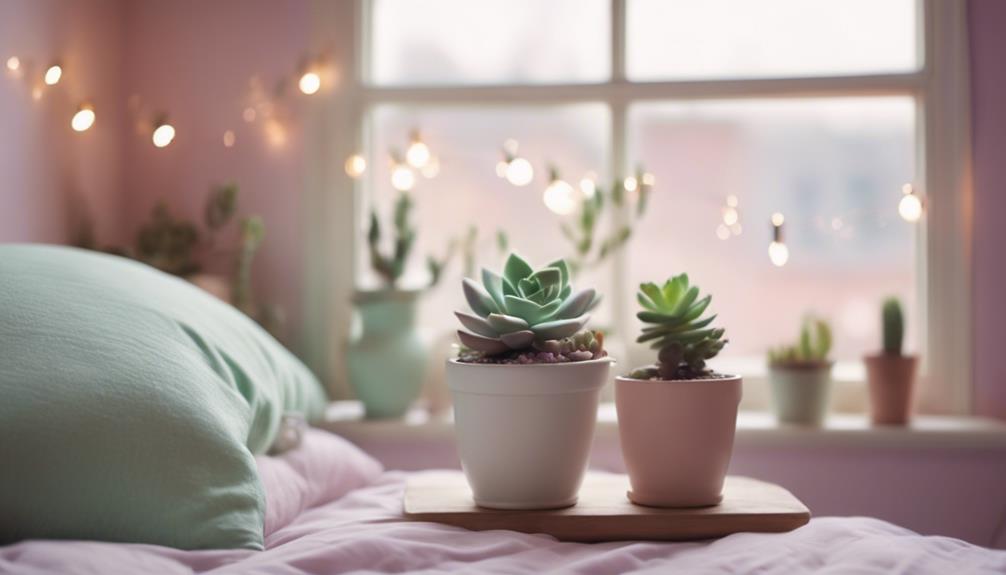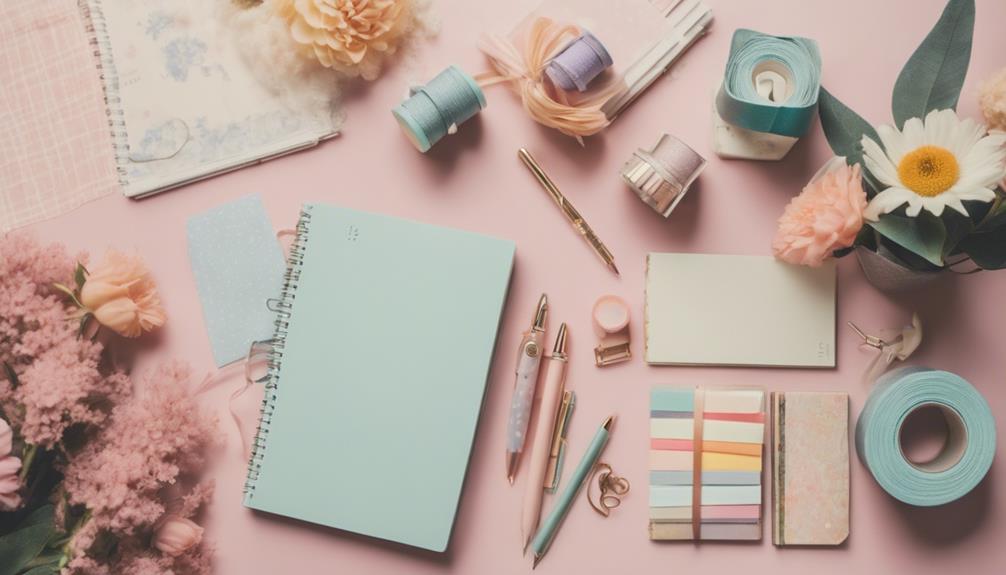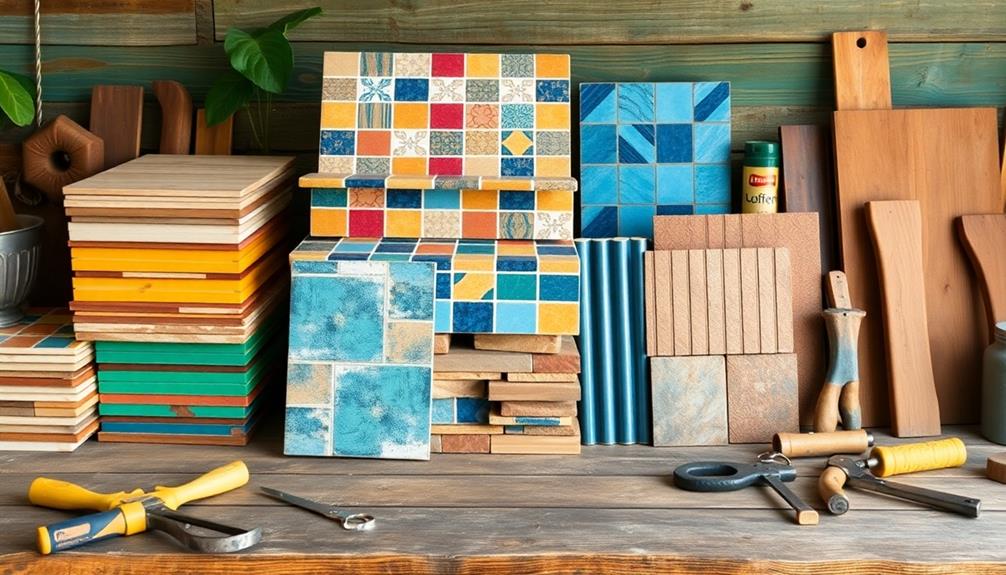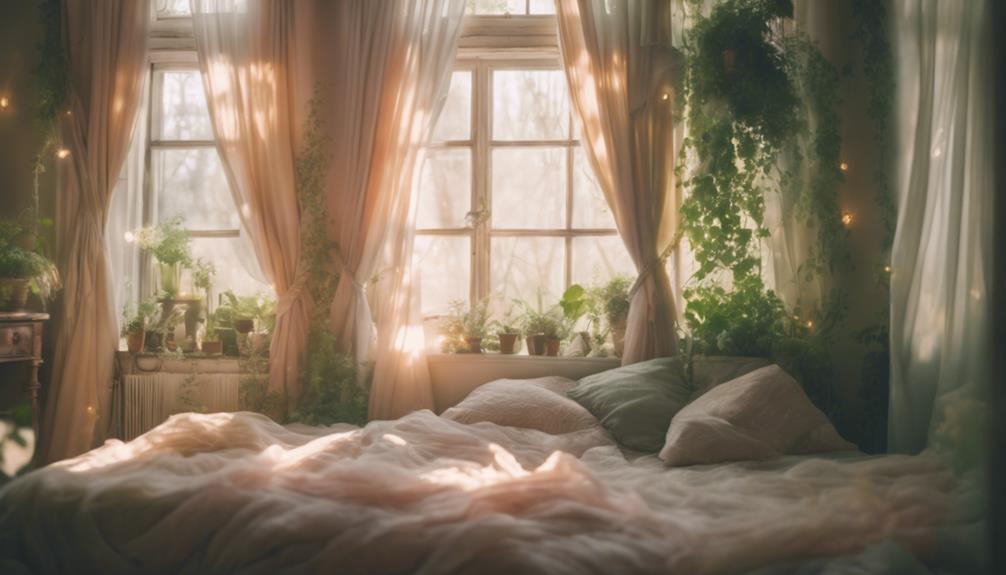To achieve a pastel aesthetic room, begin by selecting soft hues like powder pink, mint green, and light blue to create a tranquil environment. Integrate cozy materials such as plush pillows and pastel bedding for added comfort. Opt for furniture with sleek lines in pastel shades, like a velvet sofa or rounded coffee table. Elevate the mood with whimsical lighting, such as fairy lights or pastel table lamps. Lastly, adorn with art and accessories in matching pastel tones to bring cohesion to the space. You’ll quickly discover how simple it is to turn your space into a peaceful retreat, with even more tips waiting for you!
Key Elements
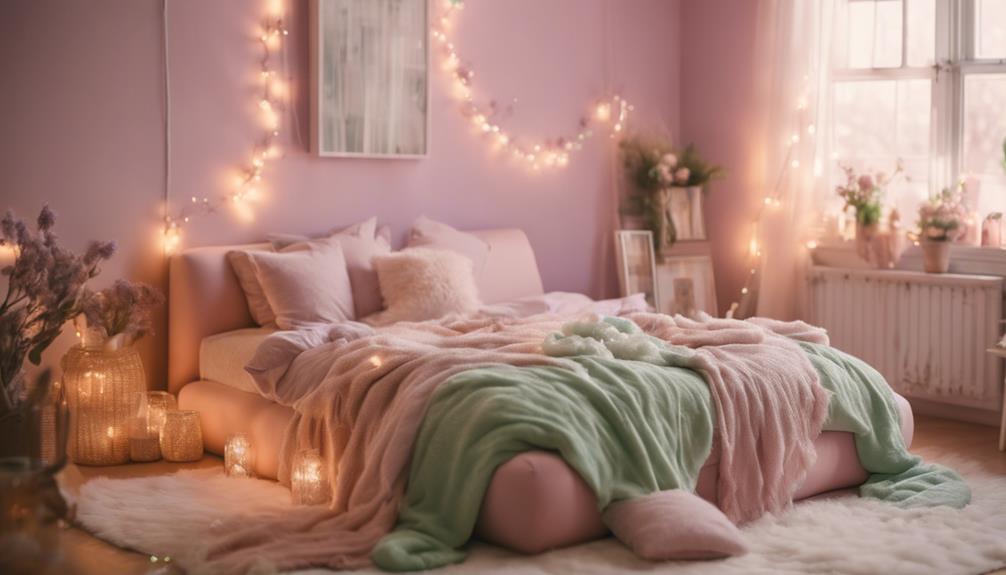
To create a true pastel aesthetic, focus on your color scheme, materials, and textures.
You'll want to choose soft hues that complement each other while selecting materials that enhance the dreamy vibe.
Textures play an essential role, so mix and match soft fabrics and smooth finishes for a cozy yet stylish look.
Color Scheme
A pastel aesthetic room thrives on a color palette filled with soft hues like powder pink, lilac, and mint green, which together create a calming and dreamy atmosphere. To achieve this, focus on incorporating a variety of pastel colors throughout the space. Light lemon yellow and light blue can also complement your main shades, adding layers of softness and warmth.
White serves as a foundational color, enhancing the pastel tones and providing a bright backdrop that keeps the room feeling airy. Pair these soft pastels with light neutrals like cream, pale gray, and soft browns to ground the vibrant colors while maintaining a light and inviting feel.
When selecting your pastel shades, consider their emotional meanings—like using pale pink for tenderness and mint green for renewal—to create a space that resonates with your personal style and promotes well-being.
Utilize pastel colors in bedding, wall art, and decorative accessories to maintain a cohesive look. This approach won't only enrich your room's aesthetic but also add visual interest and depth without overwhelming the overall design.
Embrace the beauty of soft pastels to transform your space into a serene retreat.
Materials
Incorporating key materials like soft fabrics, light woods, and playful textiles is essential for achieving that dreamy pastel aesthetic in your room. Start by selecting a color palette filled with soft pastel tones such as powder pink, mint green, lavender, and light blue, balanced with white and neutral shades. This creates a harmonious environment that feels welcoming.
Next, choose furnishings with clean lines and rounded edges in these pastel colors. This not only promotes a calming aesthetic but also keeps your room decor minimalistic. Don't forget to add nostalgic decor items like cloud cushions or rainbow art; they infuse whimsical charm and enhance the dreamy atmosphere.
Opt for pastel bedding featuring patterns like gingham or florals to serve as a focal point in your space. This adds visual interest while ensuring comfort.
Textures
Soft textiles like plush pillows and cozy throws bring comfort and enhance the dreamy quality of your pastel aesthetic room. To create an enchanting space, mix various materials like cotton, velvet, and linen. This combination adds depth and warmth, resulting in a layered effect that elevates your decor.
Incorporate pastel-colored rugs with different textures, such as shag or woven styles, to provide a soft foundation that complements your color scheme. These rugs not only feel great underfoot but also add visual interest.
Don't forget decorative accessories! Ceramic vases and glass candleholders can introduce subtle textures that break the monotony of flat surfaces, enhancing the overall aesthetic appeal.
For walls, consider pastel-painted paneling or textured wallpaper. These elements add dimension and can create a stunning focal point in your room, making your pastel aesthetic even more pronounced.
Essential Fixtures and Furniture
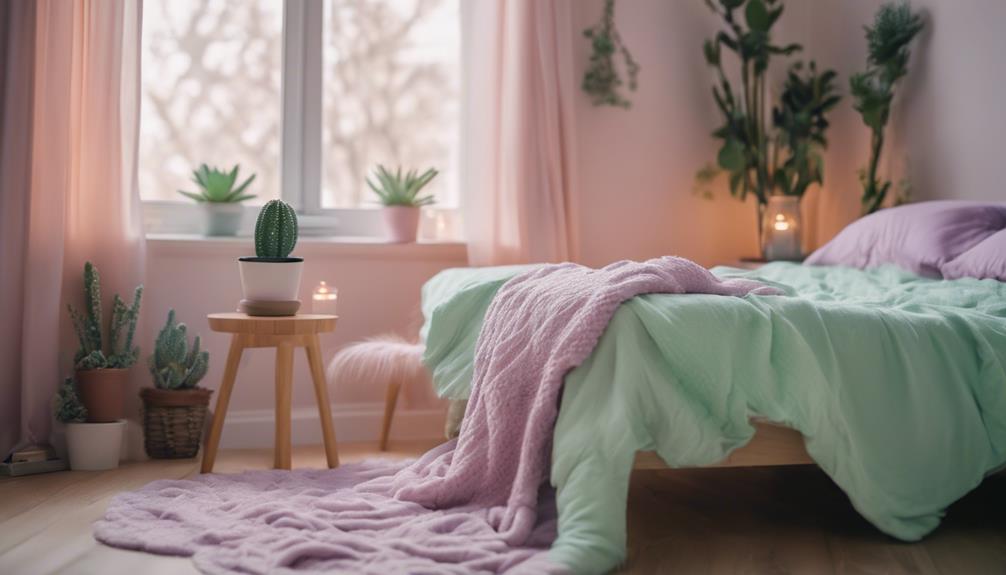
To create a cohesive pastel aesthetic, you'll want to focus on selecting essential fixtures and furniture that enhance your space.
Consider adding pastel-colored accent chairs, a plush pastel velvet sofa, and a rounded coffee table to bring both comfort and style into your room.
These pieces not only contribute to the overall look but also create a welcoming atmosphere.
Pastel-Colored Accent Chairs
Pastel-colored accent chairs, like mint green and powder pink options, can transform your space into a soothing retreat while offering stylish seating. These chairs serve as eye-catching focal points, enhancing the overall pastel aesthetic of your room.
When choosing accent chairs, look for designs with soft, rounded edges and minimalistic styles to maintain a calming atmosphere. Opt for upholstery materials in pastel hues like velvet or cotton, which not only add texture but also complement other pastel decor elements.
You might consider incorporating chairs with playful shapes, like cloud or seashell designs, to infuse a whimsical touch that aligns with the charm of pastel aesthetics. To maximize visual interest, mix and match various pastel hues among your accent chairs. This approach creates a dynamic yet cohesive look that embraces the overall pastel palette.
Pastel Velvet Sofa
Accent chairs add charm and character, but a pastel velvet sofa truly becomes the luxurious centerpiece of your pastel aesthetic room, combining comfort with a visually appealing softness. The rich texture of velvet enhances the cozy atmosphere, while pastel shades like mint green or powder pink inject a playful touch into your decor.
When you're selecting a pastel velvet sofa, prioritize rounded edges and minimalist designs. These features help maintain the calming aesthetic that defines pastel spaces. Pair your sofa with coordinating cushions or throws in complementary pastel hues to create a cohesive and inviting seating area. This not only enhances the overall look but also guarantees your space feels warm and welcoming.
To keep your pastel velvet sofa looking its best, regular maintenance is essential. Gentle vacuuming and spot cleaning will help preserve the fabric's beauty and longevity, allowing you to enjoy your stunning centerpiece for years to come. With the right pastel velvet sofa, your room will exude a soft, serene vibe that perfectly complements your pastel aesthetic vision.
Pastel Round Coffee Table
A pastel round coffee table can effortlessly elevate your room's aesthetic, blending functionality with a soft, inviting design that draws the eye. In a pastel room, this piece often serves as a focal point, available in lovely shades like mint green, blush pink, or pale yellow.
When selecting a coffee table, choose one with clean lines and rounded edges to enhance the calming effect typical of pastel aesthetics.
Materials matter too. Opt for light wood, acrylic, or painted metal, as these options not only fit the pastel theme but also guarantee durability and ease of maintenance.
To enhance the table's aesthetic appeal, incorporate decorative elements like pastel-colored coasters, small vases filled with fresh flowers, or whimsical books that reflect your personal style.
Don't forget to take into account size and scale. Your coffee table should harmonize with other furniture pieces in your pastel room, ensuring it doesn't overwhelm the space while remaining functional for everyday use.
Lighting Ideas
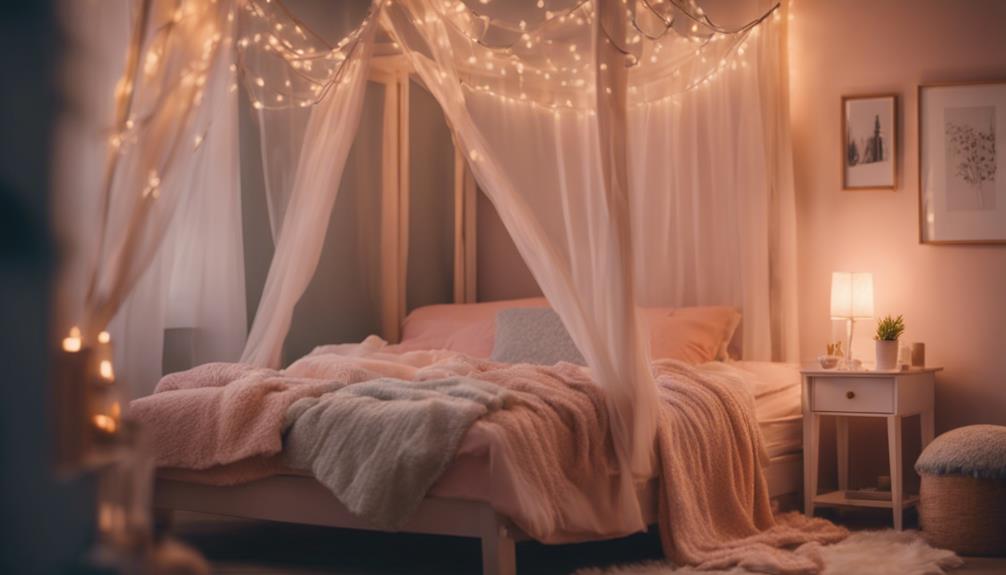
When it comes to lighting, you can really transform your pastel aesthetic room with the right fixtures.
Consider adding a pastel pendant light fixture or color-changing LED strips to set the mood.
Don't forget about pastel fairy string lights and table lamps to create that cozy, inviting atmosphere.
Pastel Pendant Light Fixture
Choosing a pastel pendant light fixture can instantly elevate your room's whimsical charm with soft hues like mint green or powder pink. These fixtures not only brighten your space but also serve as a focal point that enhances the overall aesthetic.
Look for unique shapes and designs, such as cloud or star motifs, to create a dreamy atmosphere that complements your pastel color palette.
When selecting your pendant light, consider using warm LED bulbs. They'll create a cozy ambiance, softening the light and making your pastel tones pop. Pair your pastel pendant lights with other decor elements, like cloud-shaped cushions or pastel wall art, to maintain a cohesive look throughout your room.
Adjustable pendant lights are another fantastic option, allowing you to change the height and adapt to different layouts while ensuring ideal illumination. This versatility keeps your space both functional and stylish while adhering to the pastel theme.
Pastel Color-Changing LED Strips
Pastel color-changing LED strips effortlessly transform your space by allowing you to create the perfect ambiance with soft hues like powder pink and mint green.
These versatile strips can be easily adjusted to emit a range of delicate colors, enhancing the pastel aesthetic of your room. You'll love how they can be controlled via remote or smartphone app, making it simple to switch up the mood whenever you want.
One of the best features of these LED strips is their dimming function, which lets you set the lighting to a soft glow, creating a calming atmosphere that complements your decor beautifully.
Installation is a breeze, too; just adhere the strips to walls, furniture, or even ceilings without needing any complex electrical work.
Beyond aesthetics, these energy-efficient and long-lasting lights help reduce electricity costs while adding a whimsical touch to your pastel-themed space.
Pastel Fairy String Lights
Drape pastel fairy string lights around your room to instantly create a whimsical and cozy atmosphere perfect for relaxation and creativity. These lights come in soft hues like pink, lavender, mint green, and light blue, enhancing the dreamy vibe of your pastel aesthetic. You can easily hang them along walls, wrap them around your bed frame, or suspend them from the ceiling to achieve that enchanting look.
Many pastel fairy string lights use LED bulbs, which are energy-efficient and last longer than traditional incandescent lights. This not only reduces energy consumption but also saves you money in the long run.
To make your space even more versatile, opt for dimmable pastel fairy string lights. This feature allows you to adjust the brightness, helping you set the mood for studying, unwinding, or hosting friends.
If you want more flexibility in placement, consider battery-operated pastel fairy lights. They let you arrange them creatively without being limited by power outlets.
Pastel Table Lamp With Shade
A soft glow from a pastel table lamp with a charming shade can elevate the serene atmosphere of your room while providing essential illumination.
To embrace the pastel aesthetic, consider lamps in soft pink, mint green, or lavender. These colors not only enhance the calming vibe but also add a touch of warmth. Look for designs that feature clean lines and rounded edges; minimalistic styles align beautifully with the overall aesthetic.
If you're feeling playful, opt for whimsical designs like pastel seashell lamps or flower-shaped lamps. They can serve as delightful focal points that draw the eye and spark conversation.
When selecting lampshades, choose light fabrics such as linen or cotton. These materials diffuse light gently, creating a warm and inviting ambiance that's perfect for relaxation.
To fully embrace the pastel aesthetic, layer your lighting. Combine your pastel table lamp with fairy string lights or additional lamps to create a dynamic and functional lighting scheme.
This layered approach not only enhances the overall aesthetic but guarantees your space remains well-lit and cozy. With the right pastel table lamp, your room will be transformed into a tranquil haven.
Decorative Elements
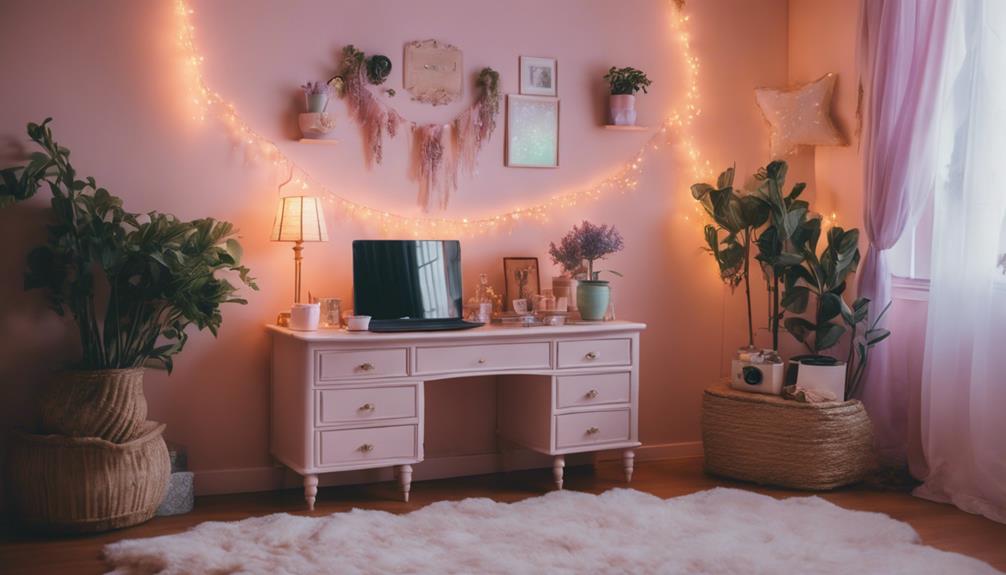
To truly elevate your pastel aesthetic room, focus on incorporating decorative elements that reflect your style.
A pastel ceramic vase arrangement can add a touch of elegance, while pastel geometric wall art brings a modern twist.
Don't forget to include pastel framed inspirational quotes to infuse positivity into your space.
Pastel Ceramic Vase Arrangement
Pastel ceramic vases in soft hues like mint green, baby pink, and lavender instantly elevate your room's decor, creating a harmonious focal point.
To make the most of these pastel ceramics, arrange vases of varying heights and shapes on a shelf or table. This variation adds visual interest while complementing your room ideas and the overall pastel color palette.
Consider filling these vases with fresh or dried flowers in coordinating pastel shades. This not only enhances the whimsical charm of your pastel aesthetic but also brings a touch of nature indoors.
For a cohesive look, group your vases with other pastel decor items, such as candle holders or decorative books. This creates a stylish arrangement that ties your decor together.
To maintain the soft, dreamy atmosphere characteristic of a pastel aesthetic room, choose ceramics with matte finishes or subtle patterns. These details evoke a serene vibe while ensuring your space feels inviting.
Pastel Geometric Wall Art
Incorporating pastel geometric wall art instantly transforms your space, adding a modern yet whimsical touch that complements the overall aesthetic.
Soft hues like powder pink, mint green, and light lavender create a soothing visual focal point, enhancing the pastel theme you're aiming for. Using shapes such as triangles, circles, and hexagons in pastel colors brings a contemporary vibe while maintaining that dreamy feel.
You can easily create a pastel geometric wall art display with canvas prints or framed posters, allowing you to update your decor with the changing seasons or your personal style.
If you're feeling crafty, try DIY options by using painter's tape to outline clean lines and shapes on a canvas, then apply pastel paint for a customized look.
Don't forget to incorporate 3D geometric elements, like wall-mounted sculptures or paper crafts in pastel shades; these can add depth and texture to your pastel-themed room.
Pastel Framed Inspirational Quotes
Framed inspirational quotes add a personal and uplifting touch to your pastel aesthetic room, enhancing the overall decor while keeping the soothing color palette intact. To maintain harmony, opt for frames in soft shades like powder pink, mint green, or light lavender. These colors will perfectly complement your pastel theme and create a cohesive look.
When selecting quotes, choose ones that resonate with positivity and creativity. Not only will they beautify your space, but they'll also inspire a calming and uplifting atmosphere. Consider typography that aligns with the whimsical nature of the pastel aesthetic—playful fonts or delicate script styles work wonders.
To maximize impact, group multiple pastel framed inspirational quotes together, creating a gallery wall effect. Mixing sizes and colors of the frames will form a visually appealing focal point in your pastel room design. This arrangement not only adds depth to your decor but also invites reflection and motivation, making your space feel more personal and inviting.
Flooring
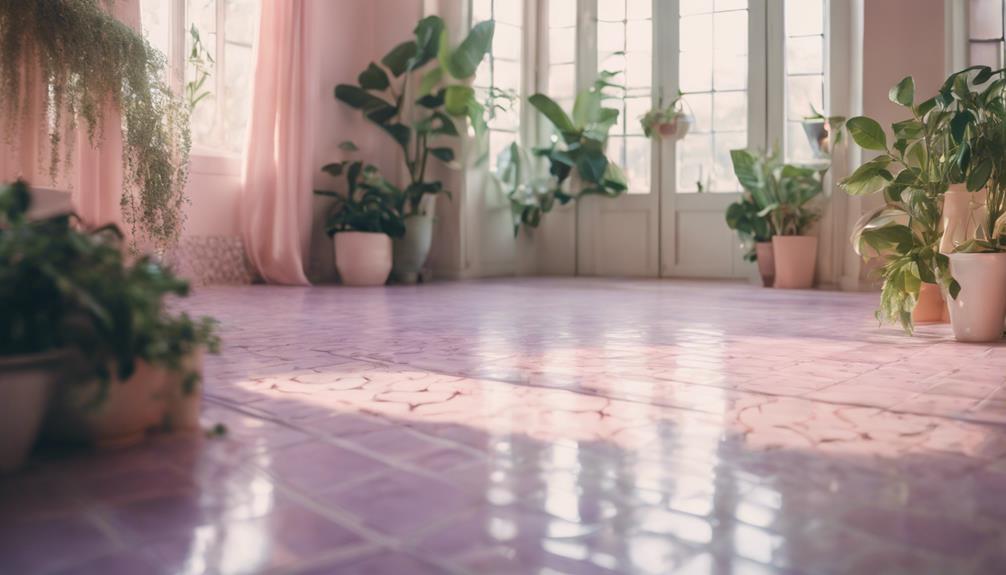
When choosing flooring for your pastel aesthetic room, consider options like pastel-hued laminate or cork tiles that blend style with durability.
A pastel patterned area rug can add warmth and a playful touch, enhancing the overall vibe.
Keep in mind how each choice complements your color palette to create a cohesive look.
Pastel-Hued Laminate Flooring
Pastel-hued laminate flooring adds a soft, inviting touch to your room while offering durability and easy maintenance. With colors like light pink, mint green, and powder blue, you can seamlessly integrate this flooring into your pastel aesthetic.
Not only does it enhance the visual appeal of your space, but it's also practical for high-traffic areas, making it ideal for everyday living. Many options mimic the look of natural wood, providing a warm atmosphere that pairs beautifully with soft decor.
This flooring can enhance natural light reflection, making your room feel brighter and more spacious, essential for achieving that serene ambiance typical of pastel-themed interior design.
The versatility of pastel laminate flooring allows it to blend effortlessly with various decor styles, from minimalist to vintage. You can create a cohesive look that aligns with your overall pastel aesthetic while enjoying the benefits of easy upkeep.
Whether you're updating a single room or your entire home, this flooring choice is a stylish and functional way to elevate your space. Embrace the charm of pastel hues and transform your room into a delightful retreat.
Pastel Patterned Area Rug
Incorporating a pastel patterned area rug can elevate your room's design by adding warmth and a playful touch that complements the soft tones of your laminate flooring.
A pastel patterned area rug serves as a focal point, enhancing your pastel aesthetic with its soft hues and cheerful designs. Popular patterns include floral motifs, checkerboard designs, and abstract shapes, all of which can seamlessly integrate with your existing pastel decor.
When selecting a rug, consider materials like cotton or plush synthetic fibers for a cozy feel underfoot. These materials not only add comfort but also align with the light and airy vibe you're aiming for. Look for rugs that incorporate multiple shades to create depth and visual interest, making it easier to coordinate with pastel furniture and accessories.
To keep your pastel rug looking vibrant, regular maintenance is key. Vacuuming and spot cleaning will help preserve the cheerful patterns, ensuring your rug remains an inviting element of your decor.
With the right pastel patterned area rug, you'll create a warm and inviting atmosphere that showcases your unique style and love for soft hues.
Pastel Cork Flooring Tiles
Choosing pastel cork flooring tiles not only enhances your room's aesthetic but also provides a sustainable and comfortable foundation for your space. These eco-friendly tiles come in various pastel shades, including soft pink, mint green, and light blue, allowing you to create a serene and inviting atmosphere that perfectly complements your pastel aesthetic.
Cork is a renewable resource harvested without harming trees, making it an ideal choice for conscious consumers. The natural properties of cork offer excellent sound insulation and cushioning, ensuring your space remains quiet and comfortable. Plus, cork tiles resist mold and mildew, making them suitable for humid environments like kitchens or bathrooms.
When it comes to maintenance, you'll appreciate how easy it is to keep your pastel cork flooring looking fresh. A simple damp mop is all you need; no harsh chemicals required. This effortless upkeep aligns beautifully with the soft and gentle feel of pastel decor, allowing you to enjoy your stylish space without added stress.
How Can I Incorporate Pastel Aesthetic in My Room Decor?
Transform your space with style by incorporating the pastel aesthetic in your room decor. Add soft, muted hues like mint green, blush pink, and baby blue. Choose pastel furniture, throw pillows, and wall art to create a calming and dreamy atmosphere. Mix and match textures for a cozy yet elegant look.
Conclusion
By incorporating these tips and inspiration, you can easily transform your space into a dreamy pastel aesthetic room.
Focus on key elements like soft furniture and gentle lighting to create a serene atmosphere.
Don't forget to add decorative touches that reflect your personality, and choose flooring that complements your vision.
With a little creativity and effort, your room won't only look beautiful but also feel like a revitalizing retreat.
Embrace the pastel vibes and enjoy your new haven!
